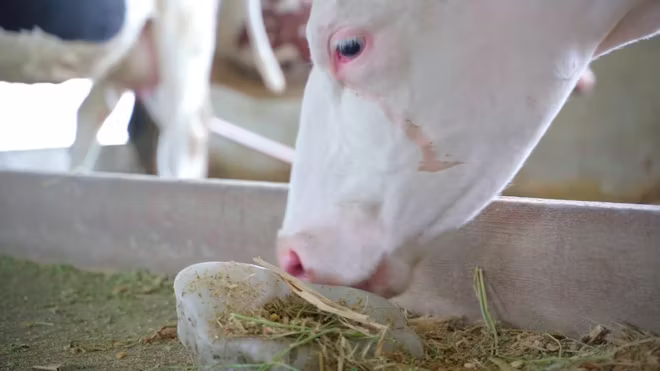Salt – An Essential for Successful Beef Production
Introduction
Cattle require a certain amount of salt in the diet to maintain their health and productivity. Salt stimulates digestion, prevents dehydration, and improves the body’s ability to absorb minerals and trace elements. Insufficient intake of salt may result in decreased appetite, slower weight gain, or even weight loss. Fertility and production may also decrease.
Salt, also known as sodium chloride (NaCl), is an essential element for plants and in the diet of humans and animals. In most regions around the world, pasture and grain are deficient in sodium (Na+) and to a lesser extent chloride (Cl-). In most situations, therefore, livestock must be fed supplemental salt to satisfy their sodium requirement. Deficiency in chloride is not common; therefore, the focus of this Bulletin is on sodium.

The role of salt in the diet
Salt consists mainly of sodium and chloride, which are essential minerals that play a vital role in maintaining the health of beef cattle. Sodium is essential for controlling osmotic pressure in the body as well as regulating the body’s fluid balance, transporting nutrients around the body, and removing waste from cells. It is also involved in nerve impulse transmission and muscle function. Chloride is essential for hydrochloric acid production in the abomasum and for carbon dioxide transport. Furthermore, it is involved in maintaining the body’s acid-base balance and helps to regulate blood pressure.
Sodium is lost through milk, urine, faeces, and sweat – this loss increases during physical activity and in hot weather. For ruminants, sodium has an added importance in saliva, which is produced in large quantities from chewing of feed during the ruminal fermentation process. Saliva contains sodium bicarbonate, which buffers and neutralises the acidic byproducts of carbohydrate (fibre, starch, and sugar) digestion. It assists to control the rumen pH at a level that is ideal for the microorganisms to function. Therefore, ruminant animals have a higher demand for sodium, and a deficiency may disturb rumen function.
Salt supplementation helps to ensure that beef cattle receive adequate amounts of these essential minerals and enhances the palatability of feed, which can increase feed intake.
Nutritional requirements
The dietary requirements of beef cattle for sodium vary depending on several factors, such as body weight, age, stage and level of production, genetics, physical activity, environmental conditions, and quality and quantity of feed and water. Guidelines for different classes and stages of beef cattle are provided by The National Research Council (NRC) in
Salt deficiency and symptoms
The daily minimum salt requirement for mature cattle is less than 30 grams/head/day. Luckily, voluntary salt intake often exceeds minimum needs. Salt deficiency is unlikely to occur in beef cattle if they have access to fresh water and adequate salt sources in their diet or environment. However, salt deficiency can occur when cattle consume low-salt feeds or water sources, when they have increased salt losses due to sweating or diarrhea, when they have increased salt requirements due to lactation or growth, or when they have reduced salt intake due to stress or illness.
Some of the signs of salt deficiency in beef cattle are:
- Reduced appetite and feed intake
- Weight loss or poor weight gain
- Reduced growth rates in young animals
- Rough coat and poor hair condition
- Pica (eating abnormal substances such as dirt, manure, urine and chewing on trees to satisfy their appetite for salt)
- Muscle weakness and tremors
- Reduced milk production in lactating cows
- Decreased fertility and reproduction
- Increased susceptibility to diseases and parasites
- Death in severe cases
Overconsumption of salt and toxicity

Cattle typically do not overconsume salt unless they are deprived for long periods of time and suddenly have free access to salt. They will overeat until their bodies’ sodium levels stabilise. Ensure free access to water during this period, as cattle will require extra water until the salt levels return to normal.
Salt toxicity is seldom seen in beef cattle because of their high tolerance for salt. The one-time lethal dose for mature cattle is 1.8 to 2.3kg of salt. Salt is rapidly absorbed from the intestinal tract into the bloodstream and then excreted by the kidneys through urine. However, salt toxicity can occur when cattle consume excess salt without adequate water intake. Salt is much more toxic when present in the drinking water of cattle. This can happen when cattle are forced to drink water with a high salt content, such as brine, whey, or brackish water. Some signs of salt toxicity in cattle are excess salivation and increased thirst, vomiting and diarrhea, anorexia, seizures, and partial paralysis as well as death in severe cases.
The importance of monitoring water quality when supplementing with salt
Water quality and freshness are critical to maximize consumption and play an important role in the production and health of beef cattle. In areas with saline soils or brackish groundwater, it is important to assess the sodium content of stock water and adjust salt supplementation accordingly. Consumption of water with more than 3,000 mg total soluble salts/litre can result in reduced feed and water intake, decreased growth, mild digestive disturbances, and diarrhea.
The use of salt mineral supplements

The minerals most likely to be deficient in beef cattle diets are sodium, calcium, phosphorus, magnesium, zinc, copper, selenium, iodine, manganese, and cobalt. A salt mineral mix developed for the geographic location of the herd can help prevent mineral deficiencies.
Recommended practices for salt mineral supplementation
To prevent salt deficiency or toxicity in beef cattle, the following practices are recommended:
Always provide adequate and consistent access to fresh water.
Always provide adequate and consistent access to salt supplements. Salt supplements can be provided as loose salt, plain white salt blocks, trace mineralised salt blocks, a salt mineral lick or mixed with feed. The type and amount of salt supplement should match the production stage and requirements of the cattle. Higher salt inclusion rates can be used to regulate daily supplement intake.
Monitor the sodium intake and water intake of the cattle regularly. Sodium intake should be within the range of 0.06% to 0.15% of DMI or 10 to 25 g/hd/d for beef cattle, which is equivalent to approximately 25 to 64 grams of salt per head per day.
Conclusion
Salt is an essential supplement for beef cattle that plays a vital role in maintaining their health. A balanced mineral nutrition is crucial to ensure animal welfare and maximize productivity. Therefore, it is important to ensure that beef cattle receive adequate amounts of sodium and chloride through salt supplementation to prevent health issues and maintain productivity.
